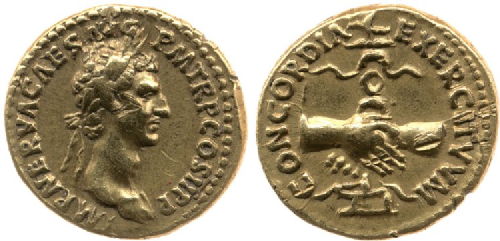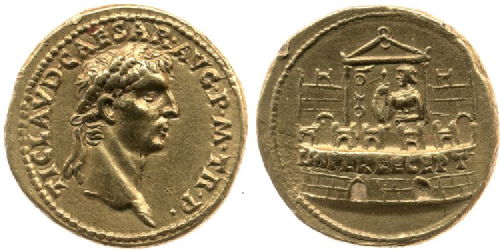All 2 entries tagged Praetorian Guard
No other Warwick Blogs use the tag Praetorian Guard on entries | View entries tagged Praetorian Guard at Technorati | There are no images tagged Praetorian Guard on this blog
July 01, 2016
The agreement of the armies under Nerva
 |
Aureus of Nerva
Date: 96 AD
Obverse: IMP NERVA CAES AUG PM TR P COS II PP (Emperor Nerva Caesar Augustus, Pontifex Maximus, Holding Tribunician power, Consul twice, Pater Patriae.)
Reverse: CONCORDIA EXERCITUUM (Agreement of the Armies), Two clasped right hands holding an Aquila set on the prow of a ship.
This particular coin is not visually exceptional since the image of clasped hands recurs on many different coin types. What makes it of interest is the message it carried, and the role this played in Nerva’s attempt to stabilise his position as Domitian’s successor. In order to understand the coin’s significance fully, we must first consider the context in which it was issued.
Nerva became emperor in September of AD 96, the year in which this coin was minted. As such, this would be among the first coins to be issued under his rule. His predecessor, Domitian, had been murdered in the Imperial palace and condemned as a tyrant by the Senate. Looking at the relative stability of Nerva’s rule as emperor, especially when compared to the civil war and instability which followed the death of Nero – the last Emperor to be violently overthrown – it can be easy to forget the dangers that the new Emperor would have faced. The reluctance of the army to shift their loyalties to an unknown Emperor is likely to have been significant in the wake of Domitian’s murder. Domitian had been a generous military leader and his succession by Nerva, who had little experience or prestige in military affairs, risked a crisis like that of the Year of the Four Emperors.
It seems that fortune was in Nerva’s favour, however, as the military situation at that time meant that a military coup was not an option. The all-important Northern armies were engaged in an ongoing war along the frontier; to return to Rome to contest Nerva would mean turning their backs to the enemy and leaving the Empire vulnerable. At the time of his accession Nerva was also already 65 years of age –perhaps they thought he wouldn’t last long enough to be worth overthrowing.
With this in mind, the Concordia Exercituum coin seems perplexing. The legend translates to “Agreement of the armies” referring to unity of armies both with each other – as signified by the military standard, ship’s prow and aquila – and the Emperor. This might seem like a strange choice of message to send at this time to military and non-military inhabitants of the empire. The majority of Romans may have been ignorant of military politics. If this celebration of army unity were aimed at them, wouldn’t it have been like announcing the existence of a previously unknown problem? It would be similar to the captain of a seemingly steady aeroplane announcing ‘There is absolutely no cause for alarm’, a statement that would only invoke suspicion and paranoia. Similarly if the Emperor felt the need to reassure citizens of the army’s loyalty, then that loyalty must be in doubt. As for the military, Nerva was no doubt aware that they would feel anything but unity with a Rome that had murdered their leader and denounced him as a tyrant. To them, receiving such a coin in their salary would surely have been laughable at best, and a grave insult at worse, as Nerva proudly announces that they are loyal to him. As a gold coin, if this type were used in military pay, it would have come into the hands of wealthier officers and individuals.
Considering the events of summer AD 97, it can be argued that Nerva (or his advisors) had taken the wrong strategy with these coins. The Praetorian Prefect, Casperius Aelianus, led the Praetorian Guard to the Imperial Palace to demand the execution of Domitian’s murderers: the freedman Parthenius and Petronius Secundus (Aelianus’ predecessor as Praetorian prefect). Petronius offered his neck to the guards, saying that he would rather die than give into their demands, and was killed immediately. Parthenius was subjected to a much more gruesome fate. He was castrated, likely a deliberate snub to Nerva who had made castration illegal, then strangled to death. The incident deeply embarrassed Nerva, as the military’s disloyalty was demonstrated publicly. It showed his failure to pacify his own army and forced him to name Trajan as his successor. Trajan was a military man, chosen in order to appease the soldiers.
But it is worth considering Nerva’s perspective further before condemning him. He had, after all, already been involved in politics during the civil wars of AD 69, and thus had personal experience in dealing with civil unrest in the aftermath of an emperor’s overthrow. He would have witnessed the events that led to Galba being murdered at the hands of the Praetorian Guard in the centre of the forum. Surely Nerva would have known the care needed to ensure the loyalty of the Roman troops. Nerva appears to have modelled most of his coinage, besides the Concordia Exercituum type, on that of Galba. It makes no sense for him to have designed a new coin, which seemed only to insult the military whose allegiance it was so essential for him to win.
Perhaps we are reading the coin wrong. It has been suggested that one key reason that the troops were hostile to Galba was that he gave no donative to the army. Syme argued that Nerva would remember the danger of forgoing the donative, and would have provided one. If the Concordia Exercituum coin was issued alongside this donative (or formed part of it), then rather than being seen as an arrogant declaration of something that was not true, the type would instead have borne a message of hope: that this gift would inspire concord between Emperor and army. If viewed by someone in Rome, the message may have been read differently. Inhabitants of Rome were surrounded by monuments celebrating Domitian’s military career, and may have viewed Nerva’s proclamation against Domitian’s established military record.
Finally, we should not see the ‘conspiracy’ of Casperius Aelianus as a complete failure on the part of Nerva. The Praetorians under his command only demanded the execution of two men, the murderers of the previous emperor, a demand that Grainger calls ‘surprisingly moderate’. When compared to other successors of overthrown emperors, such as Pertinax and Galba (both of whom were killed by the Praetorian Guard) Aelianus’ conspiracy appears more to be evidence of Nerva’s success, than failure.
 |
This month's coin was chosen and written by Nigel Heathcote. Nigel is a first year MPhil/PhD student in the Department of Classics and Ancient History at Warwick. His PhD is a study of the effects of being condemned as a tyrant upon the ‘physical legacy’ of an emperor in the city of Rome, looking at themes of destruction, appropriation and contrast. His academic interests focus on the propagation of imperial ideas through material culture.
Further Reading:
Secondary Sources
Bennett, Julian (2001) Trajan: optimus princeps (Indiana University Press)
Grainger, J.D. (2003) Nerva and the Roman succession crisis of AD 96-99 (Routledge)
Jones, B.W. (1992/3) The Emperor Domitian (Routledge).
Mattingly, H. & Sydenham ,E.A. (1926) The Roman imperial coinage. Vol.2, Vespasian to Hadrian (London)
Mattingly,H. (1936) Coins of The Roman Empire in the British Museum. Vol.3, Nerva to Hadrian (London)
Syme, R. (1930) ‘The Imperial Finances under Domitian, Nerva and Trajan’, JRS 20: pp.55-70
Primary Sources
Cassius Dio, Roman History, trans. Cary, E. (Harvard University Press, 1914)
Suetonius, The Twelve Caesars, trans. A. Thomson (Philadelphia: Gebbie & Co. 1889.)
Coin image reproduced courtesy of the Trustees of the British Museum.
January 01, 2016
Numismatics: the role of the Praetorians in the accession of Claudius
 |
RIC I2 Claudius 7
Date: AD 41 - AD 42
Denomination: Aureus
Mint: Rome
Obverse: TI CLAVD CAESAR AVG P M TR P (Tiberius Claudius Caesar Augustus, Pontifex Maximus, Holder of Tribunician Potestas). Head of Claudius, laureate, right.
Reverse: IMPER RECEPT (Imperator/Emperor Received). Battlemented wall enclosing praetorian camp; inside, soldier, holding spear, right; in front, aquila; behind, pediment with flanking walls.
Claudius rose to the position of Emperor in AD 41, after the assassination of Caligula in a conspiracy including the Praetorian commander Cassius Chaerea. Suetonius writes that a terrified Claudius took refuge by hiding in the palace (Josephus, Antiquities of the Jews 19.3). Claudius was found by the Praetorians, carried to their camp, and it was here that Suetonius reports Claudius spent the night in terror. On the following day the Praetorians chose to swear allegiance to Claudius as their newly elected emperor.
With this knowledge the coin takes on a completely different meaning from first glance, and gains far more significance (Crawford (1970) 265). It explains the iconography on the reverse of the coin, portraying the Praetorian camp, where Claudius was sworn in as emperor. The image behind the wall represents a Praetorian soldier holding a spear standing beside an aquila or “standard”. This offers an insight into the strong relationship between the Praetorian Guard and Claudius. This coin perfectly captures the change in attitude of Claudius, from Suetonius’ description of him fearing for his life at the hands of the Praetorians to instead displaying them as a symbol of safety, security and prosperity.
The Praetorian Guard, however, is shrouded by controversy in modern studies. Overall, they have received relatively little scholarly attention, yet it is almost unanimously accepted by scholars that the Praetorian Guard were used in supporting emperors’ often “ruthless” regimes (Rankov (1994) 3). This is an idea furthered by Levick’s reading of Josephus’ account, that the senate considered Claudius had seized the position of Emperor, condemning him in their eyes as a hostis or “public enemy” in much the same way as Mark Antony after the battle of Actium (Levick (2015) 40). However, with the support of the Praetorians the senate had little choice but to accept Claudius as Emperor. The power of the Praetorians is evident in this historic narrative and neatly summed up in Josephus when Veranius and Brocchus beseech Claudius not to accept the Praetorians’ backing in taking the position of emperor:
Now these ambassadors, Veranius and Brocchus, who were both of them tribunes of the people, made this speech to Claudius; and falling down upon their knees, they begged of him that he would not throw the city into wars and misfortunes; but when they saw what a multitude of soldiers encompassed and guarded Claudius, and that the forces that were with the consuls were, in comparison of them, perfectly inconsiderable, they added, that if he did desire the government, he should accept of it as given by the senate; that he would prosper better, and be happier, if he came to it, not by the injustice, but by the good-will of those that would bestow it upon him.
Josephus Antiquities of the Jews 19.4
There are clear parallels with Claudius’ rise to the position of emperor and that of Julius Caesar’s: both relied on strength of arms, although seizing power could arguably have brought great danger to Claudius. The speech of Veranius and Brocchus also draws a comparison of Claudius with “former tyrants” who had caused great afflictions to their cities (Josephus, Antiquities of the Jews 19.3). It would be easy to assume Claudius would want to distance himself from being seen as too powerful, something that may have contributed to the assassination of Julius Caesar. However, it is incredibly interesting that Claudius does not attempt to obscure the way he came to power; rather he advertises the support of the Praetorian Guard on pieces that include this coin (Levick (2015) 43-4).
The motive of the Praetorians becomes clear when we look at Suetonius, who explains that Claudius was the first Emperor to purchase the submission of the soldiers with money, promising fifteen to twenty thousand sesterces to each member of the Praetorian guard (Suetonius, Claudius 5.10). Tacitus mentions that the Praetorians rose in number from 9 to 12 cohorts in AD 47. Each cohort comprised one thousand soldiers; so assuming nine thousand soldiers at fifteen thousand sesterces each, Claudius would have been giving in the region of 135 million sesterces. The enormity of this donation may also have had a profound impact on the Urban cohort, undermining their loyalty to the senate through a sense of envy (Levick (2015) 37). Yet many coins minted at the beginning of Claudius’ reign in AD 41/42 display extremely similar iconography and it is easy to assume that a large number of these coins would end up in the hands of the Praetorians. This seems to be a clever reminder from Claudius to each soldier of the importance of the Praetorians to his rule, and a somewhat subtle attempt to avoid a similar ending to Caligula.
Here we have a perfect example of an emperor who clearly owed his rule to the praetorians and by examining the coins and literary sources there can be no doubt about the significance of the Praetorian Guard in this episode of Roman history.
 |
This month's coin was written by Miles Pearce. This is his first year at Warwick; he previously read Classics and Ancient History at Lampeter University. He is currently studying Ancient Visual and Material Culture at Masters Level, and so far has found a particular interest in reception of Greek myth in Renaissance art. However, his main interest is the Praetorian guard and their political influence.
Bibliography
 Clare Rowan
Clare Rowan

 Please wait - comments are loading
Please wait - comments are loading

 Loading…
Loading…

